Structural Formation of Soil Concretes Based on Loam and Fly Ash, Modified with a Stabilizing Polymer Additive
Abstract
:1. Introduction
2. Materials and Methods
2.1. Characteristics of the Raw Materials Used
2.2. Mix Design
2.3. Laboratory Equipment and Research Methods
3. Results and Discussion
3.1. Physical and Mechanical Properties
3.2. Scanning Electron Microscopy
3.3. X-ray Diffraction
3.4. Derivation Thermogravimetry
3.5. Infrared Spectroscopy
3.6. Biotesting
4. Conclusions
- -
- The fundamental possibility of using inactive fly ash for the composition of soil concrete was established as an effective way to solve a set of environmental problems.
- -
- The dependence of the strength characteristics of soil concrete based on loam on the mass fraction of binder and fly ash was shown. It was found that to obtain composites with maximum strength, the optimal content of fly ash and Portland cement was 10 and 8 wt.%, respectively. It was established that the use of the stabilizing additive “Kriogelit” makes it possible to obtain soil concrete of the highest strength (compressive strength 2.5 MPa, flexural strength 0.5 MPa), and frost resistance of at least F15.
- -
- It was revealed that the stabilizing additive “Kriogelit” promotes the formation of secondary soil microconglamerates and dense coagulation structure in soil concrete. In the process of structure formation, a crystallization framework of calcium silicate hydrates and calcium oxide-silicates is formed, as well as a coagulation framework of clay and dusty particles interconnected through thin layers of water and polymer. Carbonization and the formation of organomineral complexes during polymer intercalation to montmorillonite contribute to structure formation. According to its effect on the soil, the stabilizing additive “Kriogelit” is a “stabilizer-hydrophobizator”, which manifests itself in the blocking of active hydrophilic centers of smectites and quartz. In order to increase the adsorption capacity of the stabilizing additive, the minerals of the original raw mixture can be arranged in the following order: montmorillonite > microcline (feldspars) > quartz > albite.
- -
- The ecological safety of soil concrete modified with the stabilizing additive “Kriogelit” was established. It was proven by the biotesting method that the developed soil concretes do not have an acute toxic effect on test objects (Daphnia magna Straus; Chlorella vulgaris Beijer) and are safe for the environment and human health.
Author Contributions
Funding
Informed Consent Statement
Acknowledgments
Conflicts of Interest
References
- Balvanera, P.; Pfisterer, A.B.; Buchmann, N.; He, J.-S.; Nakashizuka, T.; Raffaelli, D.; Schmid, B. Quantifying the evidence for biodiversity effects on ecosystem functioning and services. Ecol. Lett. 2006, 9, 1146–1156. [Google Scholar] [CrossRef] [PubMed] [Green Version]
- Goldscheider, N. A holistic approach to groundwater protection and ecosystem services in karst terrains. Carbonates Evaporites 2019, 34, 1241–1249. [Google Scholar] [CrossRef]
- Mokany, K.; Harwood, T.D.; Ferrier, S. Improving links between environmental accounting and scenario-based cumulative impact assessment for better-informed biodiversity decisions. J. Appl. Ecol. 2019, 56, 2732–2741. [Google Scholar] [CrossRef]
- Teckentrup, L.; Kramer-Schadt, S.; Jeltsch, F. The risk of ignoring fear: Underestimating the effects of habitat loss and fragmentation on biodiversity. Landsc. Ecol. 2019, 34, 2851–2868. [Google Scholar] [CrossRef]
- Bian, Z.; Miao, X.; Lei, S.; Chen, S.E.; Wang, W.; Struthers, S. The challenges of reusing mining and mineral processing wastes. Science 2012, 337, 702–703. [Google Scholar] [CrossRef] [PubMed]
- Mymrin, V.; Presotto, P.; Alekseev, K.; Avanci, M.A.; Rolim, P.H.B.; Petukhov, V.; Taskin, A.; Gidarakos, E.; Yu, V.A.G. Application of hazardous serpentine rocks’ extraction wastes in composites with glass waste and clay-sand mix to produce environmentally clean construction materials. Constr. Buiding Mater. 2020, 234, 117319. [Google Scholar] [CrossRef]
- Semenov, P.; Uzunian, A.; Davidenko, A.; Al, E. First study of radiation hardness of lead tungstate crystals at low temperatures, Nucl. Instruments Methods Phys. Res. Sect. A Accel. Spectrometers Detect. Assoc. Equip. 2007, 582, 575–580. [Google Scholar] [CrossRef] [Green Version]
- Dave, J.M. Disposal of fly ash—An environmental problem. Int. J. Environ. Stud. 1986, 26, 191–215. [Google Scholar]
- Borm, P.J.A. Toxicity and occupational health hazards of coal fly ash (CFA). A review of data and comparison to coal mine dust. Ann. Occup. Hyg. 1997, 41, 659–676. [Google Scholar] [CrossRef]
- Ribeiro, J.; Silva, T.F.; Filho, J.G.M.; Flores, D. Fly ash from coal combustion—An environmental source of organic compounds. Appl. Geochem. 2014, 44, 103–110. [Google Scholar] [CrossRef]
- Pandey, V.C.; Singh, N. Impact of fly ash incorporation in soil systems. Agric. Ecosyst. Environ. 2010, 136, 16–27. [Google Scholar] [CrossRef]
- Sahu, S.K.; Bhangare, R.C.; Ajmal, P.Y.; Sharma, S.; Pandit, G.G.; Puranik, V.D. Characterization and quantification of persistent organic pollutants in fly ash from coal fueled thermal power stations in India. Microchem. J. 2009, 92, 92–96. [Google Scholar] [CrossRef]
- Abdrakhimov, V.Z. Use of aluminum-containing waste in production of ceramic materials for various purposes. Refract. Ind. Ceram. 2013, 54, 2–6. [Google Scholar] [CrossRef]
- Li, C.; Zhou, Y.; Tian, Y.; Zhao, Y.; Wang, K.; Li, G.; Chai, Y. Preparation and characterization of mullite whisker reinforced ceramics made from coal fly ash. Ceram. Int. 2019, 45, 5613–5616. [Google Scholar] [CrossRef]
- Luo, Y.; Wu, Y.-H.; Ma, S.-H.; Zheng, S.-L.; Chu, P.K. An eco-friendly and cleaner process for preparing architectural ceramics from coal fly ash: Pre-activation of coal fly ash by a mechanochemical method. J. Clean. Prod. 2019, 214, 419–428. [Google Scholar] [CrossRef]
- Shakir, A.A.; Naganathan, S.; Mustapha, K.N. Properties of bricks made using fly ash, quarry dust and billet scale. Constr. Build. Mater. 2013, 41, 131–138. [Google Scholar] [CrossRef]
- Cengizler, H.; Koç, M.; Şan, O. Production of ceramic glass foam of low thermal conductivity by a simple method entirely from fly ash. Ceram. Int. 2021, 47, 28460–28470. [Google Scholar] [CrossRef]
- Papadakis, V.G. Effect of fly ash on Portland cement systems: Part 1. Low-calcium fly ash. Cem. Concr. Res. 1999, 29, 1727–1736. [Google Scholar] [CrossRef]
- Nithyanandam, A.; Deivarajan, T. Development of fly ash cenosphere-based composite for thermal insulation application. Int. J. Appl. Ceram. Technol. 2021, 18, 1825–1831. [Google Scholar] [CrossRef]
- Chernysheva, N.; Lesovik, V.; Fediuk, R.; Vatin, N. Improvement of Performances of the Gypsum-Cement Fiber Reinforced Composite (GCFRC). Materials 2020, 13, 3847. [Google Scholar] [CrossRef]
- Sharonova, O.M.; Yumashev, V.V.; Solovyov, L.A.; Anshits, A.G. The fine high-calcium fly ash as the basis of composite cementing material. Mag. Civ. Eng. 2019, 91, 60–72. [Google Scholar]
- Kim, S.-J.; Yang, K.-H.; Moon, G.-D. Hydration characteristics of low-heat cement substituted by fly ash and limestone powder. Materials 2015, 8, 5847–5861. [Google Scholar] [CrossRef] [PubMed] [Green Version]
- Dandautiya, R.; Singh, A.P. Utilization potential of fly ash and copper tailings in concrete as partial replacement of cement along with life cycle assessment. Waste Manag. 2019, 99, 90–101. [Google Scholar] [CrossRef] [PubMed]
- Prošek, Z.; Nežerka, V.; Hlůžek, R.; Trejbal, J.; Tesárek, P.; Karra’a, G. Role of lime, fly ash and slag in cement pastes containing recycled concrete fine. Constr. Build. Mater. 2019, 201, 702–714. [Google Scholar] [CrossRef]
- Satpathy, H.P.; Patel, S.K.; Nayak, A.N. Development of sustainable lightweight concrete using fly ash cenosphere and sintered fly ash aggregate. Constr. Build. Mater. 2019, 202, 636–655. [Google Scholar] [CrossRef]
- Fediuk, R.S.; Yushin, A.M. The use of fly ash the thermal power plants in the construction. IOP Conf. Ser. Mater. Sci. Eng. 2015, 93, 012070. [Google Scholar] [CrossRef]
- Ling, Y.; Wang, K.; Li, W.; Shi, G.; Lu, P. Effect of slag on the mechanical properties and bond strength of fly ash—Based engineered geopolymer composites. Compos. Part B Eng. 2019, 164, 747–757. [Google Scholar] [CrossRef]
- Chintalapudi, K.; Pannem, R.M.R. Enhanced Strength, Microstructure, and Thermal properties of Portland Pozzolana Fly ash-based cement composites by reinforcing Graphene Oxide nanosheets. J. Build. Eng. 2021, 42, 102521. [Google Scholar] [CrossRef]
- Fediuk, R.S.; Smoliakov, A.K.; Timokhin, R.A.; Batarshin, V.O.; Yevdokimova, Y.G. Using thermal power plants waste for building materials. IOP Conf. Ser. Earth Environ. Sci. 2017, 87, 092010. [Google Scholar] [CrossRef] [Green Version]
- Cetin, B.; Aydilek, A.H.; Guney, Y. Stabilization of recycled base materials with high carbon fly ash. Resour. Conserv. Recycl. 2010, 54, 878–892. [Google Scholar] [CrossRef] [Green Version]
- Edil, T.B.; Acosta, H.A.; Benson, C.H. Stabilizing soft fine-grained soils with fly ash. J. Mater. Civ. Eng. 2006, 18, 283–294. [Google Scholar] [CrossRef]
- Kaniraj, S.R.; Havanagi, V.G. Compressive strength of cement stabilized fly ash—Soil mixtures. Cem. Concr. Res. 1999, 29, 673–677. [Google Scholar] [CrossRef]
- Dermatas, D.; Meng, X. Utilization of fly ash for stabilization/solidification of heavy metal contaminated soils. Eng. Geol. 2003, 70, 377–394. [Google Scholar] [CrossRef]
- Bin-Shafique, S.; Rahman, K.; Yaykiran, M.; Azfar, I. The long-term performance of two fly ash stabilized fine grained soil subbases. Resour. Conserv. Recycl. 2010, 54, 666–672. [Google Scholar] [CrossRef]
- Correns, C.W. The Experimental Chemical Weathering of Silicates. Clay Minerals Bull. Mineral. Inst. 1961, 26, 4. [Google Scholar]
- Herzod, A.; Mitchell, J. Reactions Accompaning Stabilization of Clay with Cement. Cem. Treat. Soil Mix. Highw. Res. Rec. 1962, 36, 146–171. [Google Scholar]
- Dunn, C.S.; Salem, M.N. Temperature and Time Effects on the Shear Strength of Sand Stabilized with Cationic Bitumen Emulsion. Highw. Res. Rec. 1973, 442, 113–124. [Google Scholar]
- Hilt, G.H.; Davidson, D.T. Isolation and Investigation of a Lime Montmorillonite; Bulletin No. 262, Highway Research Board Bulletin, 1961; Highway Research Board: Washington, DC, USA, 1961; pp. 20–32. [Google Scholar]
- Laguros, J.G.; Davidson, D.T. Effect of Chemicals on Soil-Cement Stabilization. Highw. Res. Rec. 1963, 36, 172–203. [Google Scholar]
- Kianimehr, M.; Shourijeh, P.T.; Binesh, S.M.; Mohammadinia, A.; Arulrajah, A. Utilization of recycled concrete aggregates for light-stabilization of clay soils. Constr. Build. Mater. 2019, 227, 116792. [Google Scholar] [CrossRef]
- Chen, K.; Wu, D.; Zhang, Z.; Pan, C.; Shen, X.; Xia, L.; Zang, J. Modeling and optimization of fly ash–slag-based geopolymer using response surface method and its application in soft soil stabilization. Constr. Build. Mater. 2021, 315, 125723. [Google Scholar] [CrossRef]
- Kulkarni, P.P.; Mandal, J.N. Strength evaluation of soil stabilized with nano silica- cement mixes as road construction material. Constr. Build. Mater. 2022, 314, 125363. [Google Scholar] [CrossRef]
- Huang, J.; Kogbara, R.B.; Hariharan, N.; Masad, E.A.; Little, D.N. A state-of-the-art review of polymers used in soil stabilization. Constr. Build. Mater. 2021, 305, 124685. [Google Scholar] [CrossRef]
- Saldanha, R.B.; da Rocha, C.G.; Caicedo, A.M.L.; Consoli, N.C. Technical and environmental performance of eggshell lime for soil stabilization. Constr. Build. Mater. 2021, 298, 123648. [Google Scholar] [CrossRef]
- Gonzalez, J.; Sargent, P.; Ennis, C. Sewage treatment sludge biochar activated blast furnace slag as a low carbon binder for soft soil stabilisation. J. Clean. Prod. 2021, 311, 127553. [Google Scholar] [CrossRef]
- Zhang, X.; Li, W.; Tang, Z.; Wang, X.; Sheng, D. Sustainable regenerated binding materials (RBM) utilizing industrial solid wastes for soil and aggregate stabilization. J. Clean. Prod. 2020, 275, 122991. [Google Scholar] [CrossRef]
- Renjith, R.; Robert, D.; Setunge, S.; Costa, S.; Mohajerani, A. Optimization of fly ash based soil stabilization using secondary admixtures for sustainable road construction. J. Clean. Prod. 2021, 294, 126264. [Google Scholar] [CrossRef]
- Corrêa-Silva, M.; Miranda, T.; Rouainia, M.; Araújo, N.; Glendinning, S.; Cristelo, N. Geomechanical behaviour of a soft soil stabilised with alkali-activated blast-furnace slags. J. Clean. Prod. 2020, 267, 122017. [Google Scholar] [CrossRef]
- Zhang, T.; Liu, S.; Zhan, H.; Ma, C.; Cai, G. Durability of silty soil stabilized with recycled lignin for sustainable engineering materials. J. Clean. Prod. 2020, 248, 119293. [Google Scholar] [CrossRef]
- Safi, W.; Singh, S. Efficient & effective improvement and stabilization of clay soil with waste materials. Mater. Today Proc. 2022, 51, 947–955. [Google Scholar] [CrossRef]
- Zinchenko, A.; Sakai, T.; Morikawa, K.; Nakano, M. Efficient stabilization of soil, sand, and clay by a polymer network of biomass-derived chitosan and carboxymethyl cellulose. J. Environ. Chem. Eng. 2022, 10, 107084. [Google Scholar] [CrossRef]
- Abbey, S.J.; Eyo, E.U.; Okeke, C.A.U.; Ngambi, S. Experimental study on the use of RoadCem blended with by-product cementitious materials for stabilisation of clay soils. Constr. Build. Mater. 2021, 280, 122476. [Google Scholar] [CrossRef]
- Pokharel, B.; Siddiqua, S. Effect of calcium bentonite clay and fly ash on the stabilization of organic soil from Alberta, Canada. Eng. Geol. 2021, 293, 106291. [Google Scholar] [CrossRef]
- Fediuk, R.; Yushin, A. Composite binders for concrete with reduced permeability. IOP Conf. Ser. Mater. Sci. Eng. 2016, 116, 012021. [Google Scholar] [CrossRef]
- Smirnova, O.M.; Potyomkin, D.A. Influence of ground granulated blast furnace slag properties on the superplasticizers effect. Int. J. Civ. Eng. Technol. 2018, 9, 874–880. [Google Scholar]
- Alhokabi, A.; Hasan, M.; Amran, M.; Fediuk, R.; Vatin, N.I.; Alshaeer, H. The Effect of POFA-Gypsum Binary Mixture Replacement on the Performance of Mechanical and Microstructural Properties Enhancements of Clays. Materials 2022, 15, 1532. [Google Scholar] [CrossRef] [PubMed]
- Al-hokabi, A.; Hasan, M.; Amran, M.; Fediuk, R.; Vatin, N.I.; Klyuev, S. Improving the early properties of treated soft kaolin clay with palm oil fuel ash and gypsum. Sustainability 2021, 13, 10910. [Google Scholar] [CrossRef]
- Sha, A.-M.; Hu, L.-Q. Structural characteristics of semi-rigid base course material. Zhongguo Gonglu Xuebao/China J. Highw. Transp. 2008, 21, 1–5. [Google Scholar]
- Upadhyaya, S.; Tiwari, B.; Olgun, G. Static and dynamic properties of compacted soil-cement mixtures. Geotech. Struct. Eng. Congr. 2016, 2016, 1646–1654. [Google Scholar]
- Sha, A.-M.; Hu, L.-Q. Structural characteristics of stabilized base materials. Ninth Int. Conf. Bear. Capacit. Roads Railw. Airfields 2013, 2, 949–958. [Google Scholar]
- Hubbard, C.R.; Evans, E.H.; Smith, D.K. The Reference Intensity Ratio, I/IC, for Computer Simulated Powder Patterns. J. Appl. Crystallogr. 1976, 9, 169–174. [Google Scholar] [CrossRef] [Green Version]




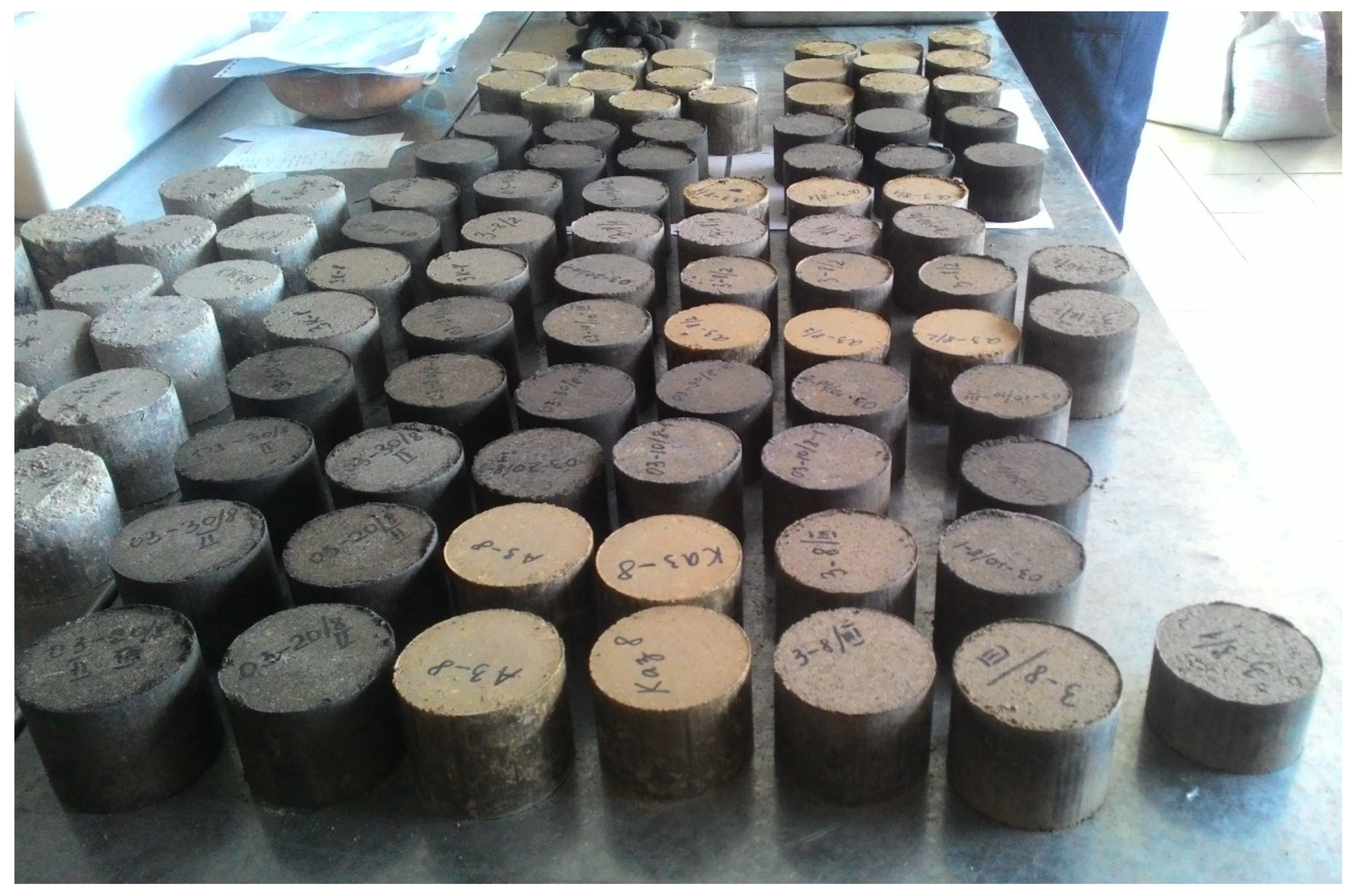
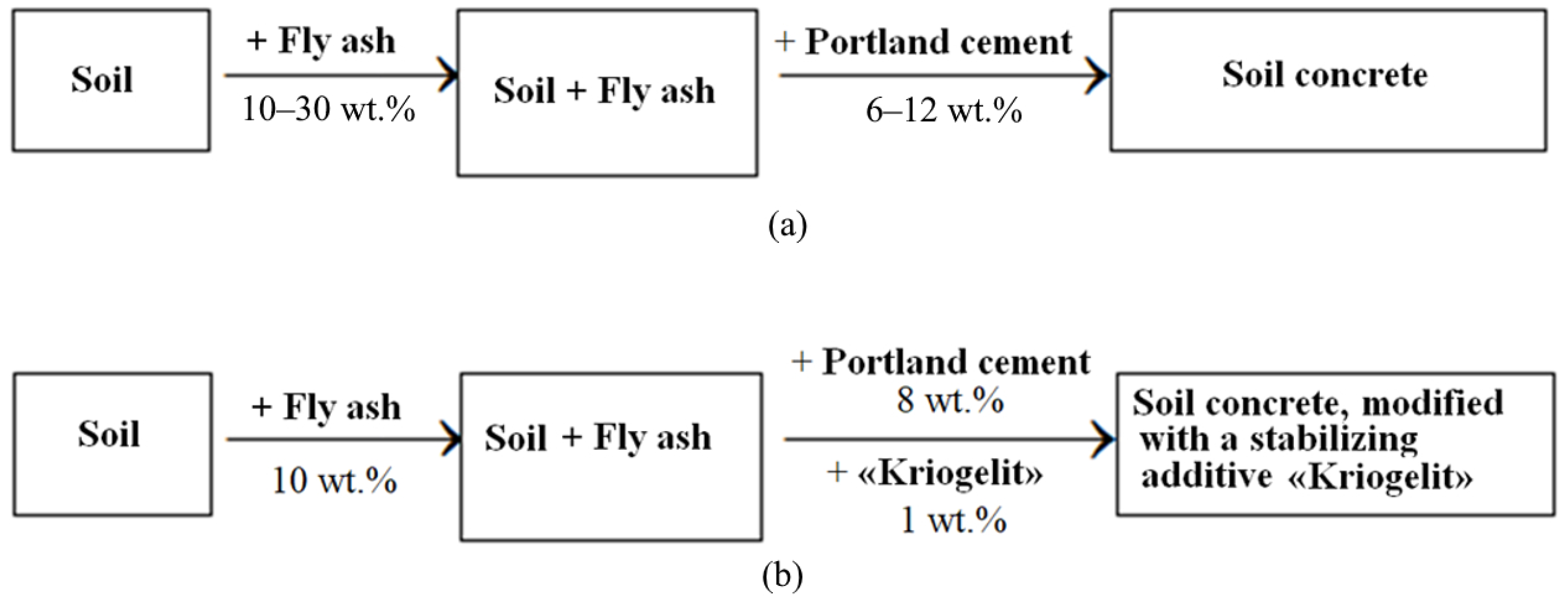
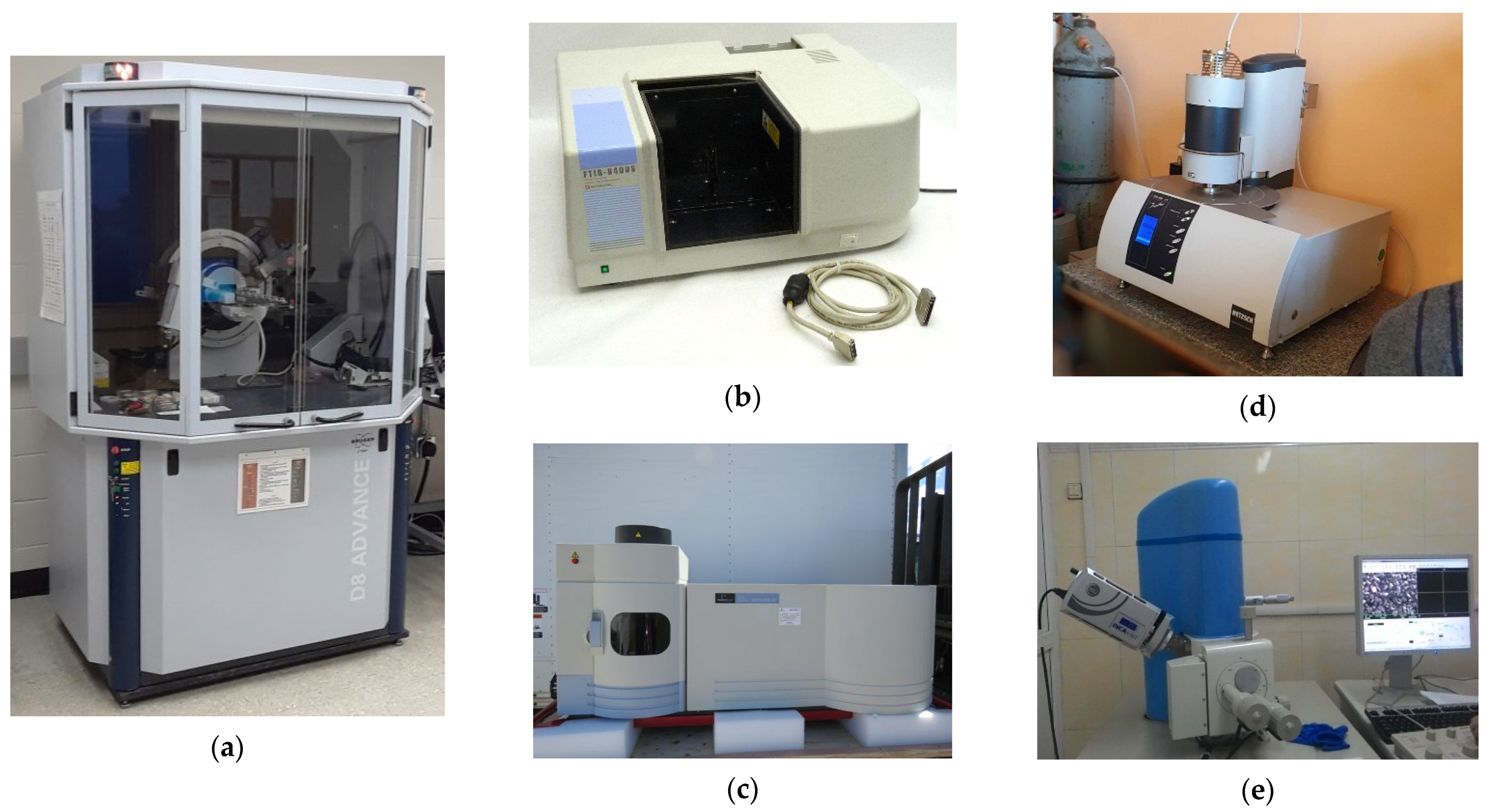
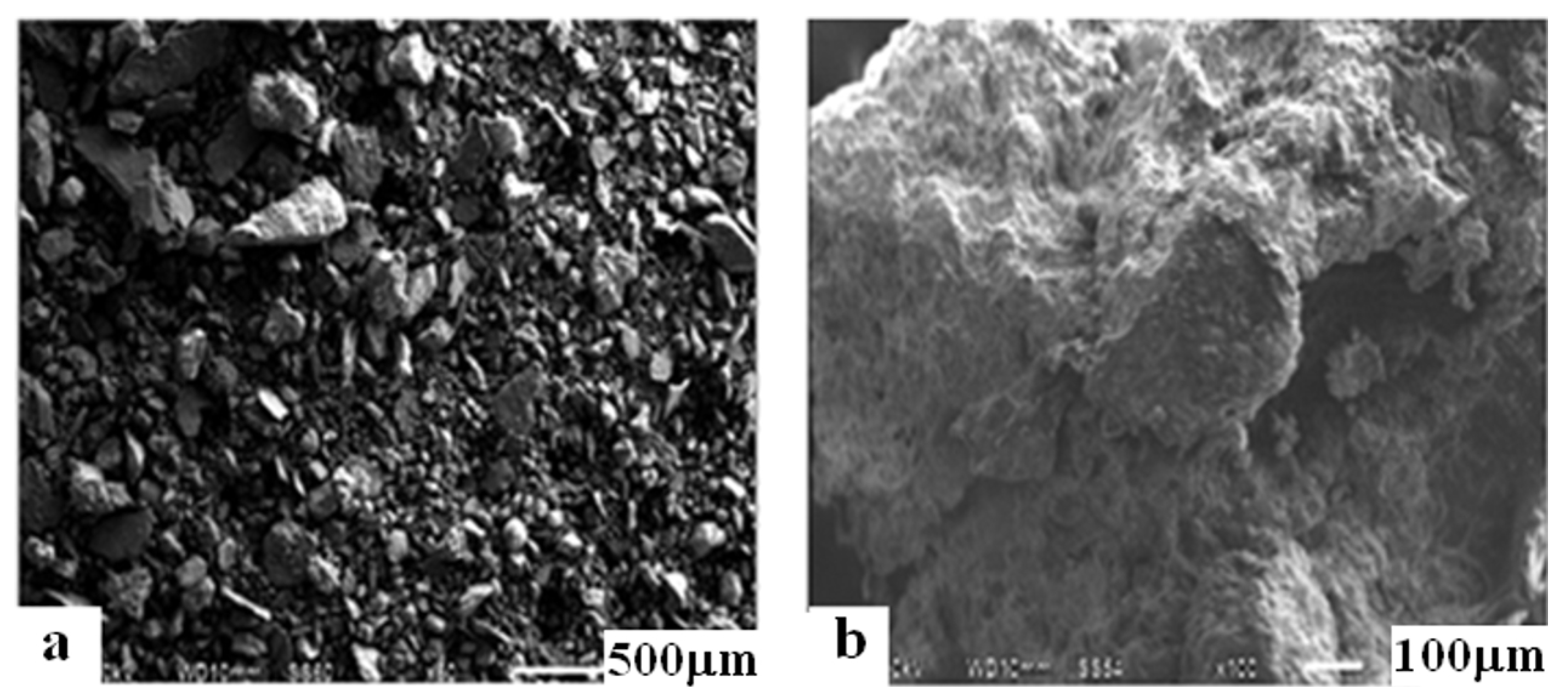

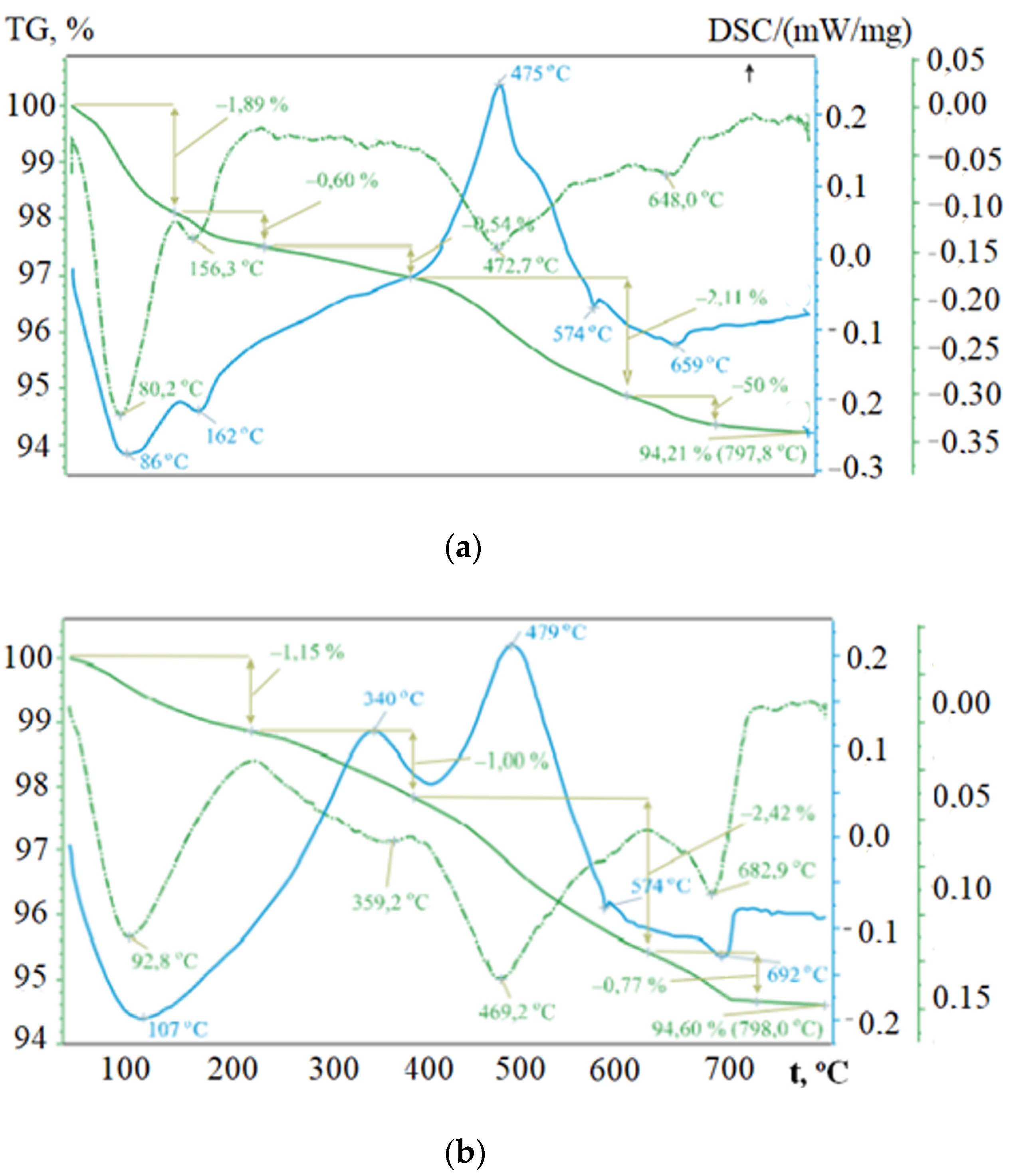
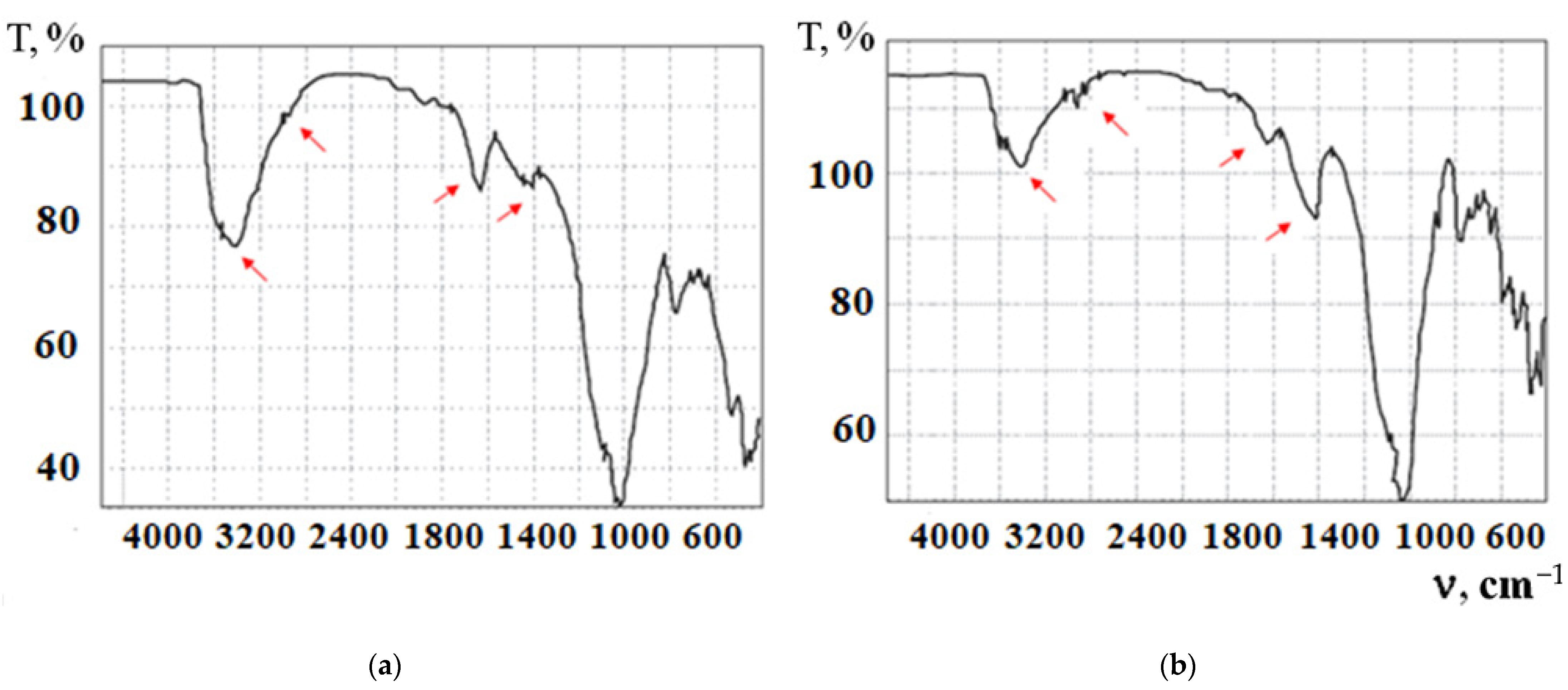
| Remains on Sieves, % by Weight | Diameter of Holes of Control Sieves, mm | ||||||
|---|---|---|---|---|---|---|---|
| 1.25 | 0.63 | 0.315 | 0.14 | 0.08 | 0.071 | <0.071 | |
| partially | 0.32 | 2.42 | 41.65 | 19.17 | 6.22 | 3.52 | 26.72 |
| full | 0.32 | 2.74 | 44.39 | 63.55 | 69.77 | 73.28 | 100.00 |
| Properties | Values |
|---|---|
| Humidity, % | 0.59 |
| Bulk density, kg/m3 | 660 |
| True density, kg/m3 | 2240 |
| Specific surface area, m2/kg | 276 |
| Total remainder of the ash fraction, % | 25.39 |
| Bituminous capacity, g | 54 |
| Basicity module M0 | 0.17 |
| Silicate module Mc | 1.82 |
| Quality factor K | 0.58 |
| CaOtotal, wt.% | 9.24 |
| CaOfree, wt.% | 0.40 |
| Activity group | hidden-active |
| Properties | Designations, Units of Measurement | Values |
|---|---|---|
| Soil density | ρ, g/cm³ | 2.0 |
| Density of soil particles | ρs, g/cm³ | 2.7 |
| Density of dry soil | ρd, g/cm³ | 1.6 |
| Clay mineral content | ω, wt.% | 39.0 |
| Porosity coefficient | e, - | 0.7 |
| Natural soil moisture | W, fractions of a unit. | 0.3 |
| Moisture at the pour point | WL, fractions of a unit. | 0.4 |
| Moisture at the rolling edge | Wp, fractions of a unit. | 0.2 |
| Plasticity number | Ip, fractions of a unit. | 0.2 |
| Indicator of fluidity | IL, fractions of a unit | 0.1 |
| Specific adhesion | c, kPa | 29 |
| Angle of internal friction of soil | φ, ° | 26 |
| Soil deformation modulus | E, MPa | 25 |
| Raw Material | Al2O3 | CaO | Fe2O3 | MgO | SiO2 | SO3 | TiO2 | Other | LOI |
|---|---|---|---|---|---|---|---|---|---|
| Portland cement | 7.4 | 40.8 | 4.2 | 3.9 | 27.9 | 2.8 | - | 13.0 | - |
| Fly ash | 21.0 | 9.4 | 9.0 | 1.3 | 53.0 | 1.0 | 1.0 | 2.5 | 1.8 |
| Loam | 13.0 | 0.3 | 0.9 | 0.3 | 66.0 | - | 0.2 | 14.3 | 5.0 |
| ω, wt.% | Mix ID | |||||||||||||||
|---|---|---|---|---|---|---|---|---|---|---|---|---|---|---|---|---|
| 1 | 2 | 3 | 4 | 5 | 6 | 7 | 8 | 9 | 10 | 11 | 12 | 13 | 14 | 15 | 16 | |
| Soil | 84 | 74 | 64 | 94 | 82 | 72 | 62 | 92 | 80 | 70 | 60 | 90 | 78 | 68 | 58 | 88 |
| Portland cement | 6 | 6 | 6 | 6 | 8 | 8 | 8 | 8 | 10 | 10 | 10 | 10 | 12 | 12 | 12 | 12 |
| Fly ash | 10 | 20 | 30 | 0 | 10 | 20 | 30 | 0 | 10 | 20 | 30 | 0 | 10 | 20 | 30 | 0 |
| Properties | Mix ID | |||||||||||||||
|---|---|---|---|---|---|---|---|---|---|---|---|---|---|---|---|---|
| 1 | 2 | 3 | 4 | 5 | 6 | 7 | 8 | 9 | 10 | 11 | 12 | 13 | 14 | 15 | 16 | |
| Compressive strength (hardening in water), MPa | 1.6 | 1.5 | 1.4 | 1.6 | 1.7 | 1.7 | 1.7 | 1.7 | 1.7 | 1.6 | 1.3 | 1.7 | 0.8 | 0.7 | 0.6 | 1.0 |
| Compressive strength, (hardening in air), MPa | 1.7 | 1.6 | 1.6 | 1.8 | 2.2 | 2.2 | 2.0 | 2.5 | 2.0 | 2.1 | 1.8 | 2.5 | 1.8 | 1.7 | 1.5 | 1.9 |
| Flexural strength, MPa | 0.4 | 0.5 | 0.4 | 0.5 | 0.5 | 0.5 | 0.4 | 0.5 | 03 | 0.3 | 0.2 | 0.3 | 0.2 | - | - | 0.3 |
| Frost resistance grade | F5 | F0 | F5 | F5 | F10 | F5 | F5 | F5 | F5 | F5 | F0 | F10 | F5 | F5 | F0 | F10 |
| Mix ID | Compressive Strength, MPa | Flexural Strength, MPa | Compressive Strength, (at Air Hardening), MPa | Frost Resistance Grade | ||
|---|---|---|---|---|---|---|
| Water Saturation | ||||||
| Capillary | Full | Capillary | Full | |||
| ID 1 with 1% Kriogelit” | 2.02 | 2.08 | 1.08 | 1.04 | 3.69 | F15 |
| ID 5 with 1% Kriogelit” | 2.91 | 2.54 | 1.28 | 1.36 | 3.92 | F15 |
| ID 9 with 1% Kriogelit” | 2.50 | 2.40 | 1.42 | 1.42 | 3.12 | F15 |
| ID 13 with 1% Kriogelit” | 2.65 | 2.38 | 1.50 | 1.48 | 3.00 | F15 |
| Indicators | Test Objects | ||
|---|---|---|---|
| Daphnia magna Straus | Chlorella vulgaris Beijer | ||
| Duration, Hour | 96 | 22 | |
| Biotesting results | Mortality to control, % | The relative difference in the average value of optical density for each dilution in comparison with the control, % | |
| Dilution ratio | 1 | 6.5 | 4.2 |
| 10 | 3.1 | 7.4 | |
| 100 | 3.0 | 14.0 | |
| Sample evaluation | does not have an acute toxic effect | ||
Publisher’s Note: MDPI stays neutral with regard to jurisdictional claims in published maps and institutional affiliations. |
© 2022 by the authors. Licensee MDPI, Basel, Switzerland. This article is an open access article distributed under the terms and conditions of the Creative Commons Attribution (CC BY) license (https://creativecommons.org/licenses/by/4.0/).
Share and Cite
Konovalova, N.; Pankov, P.; Petukhov, V.; Fediuk, R.; Amran, M.; Vatin, N.I. Structural Formation of Soil Concretes Based on Loam and Fly Ash, Modified with a Stabilizing Polymer Additive. Materials 2022, 15, 4893. https://doi.org/10.3390/ma15144893
Konovalova N, Pankov P, Petukhov V, Fediuk R, Amran M, Vatin NI. Structural Formation of Soil Concretes Based on Loam and Fly Ash, Modified with a Stabilizing Polymer Additive. Materials. 2022; 15(14):4893. https://doi.org/10.3390/ma15144893
Chicago/Turabian StyleKonovalova, Nataliya, Pavel Pankov, Valery Petukhov, Roman Fediuk, Mugahed Amran, and Nikolai Ivanovich Vatin. 2022. "Structural Formation of Soil Concretes Based on Loam and Fly Ash, Modified with a Stabilizing Polymer Additive" Materials 15, no. 14: 4893. https://doi.org/10.3390/ma15144893






